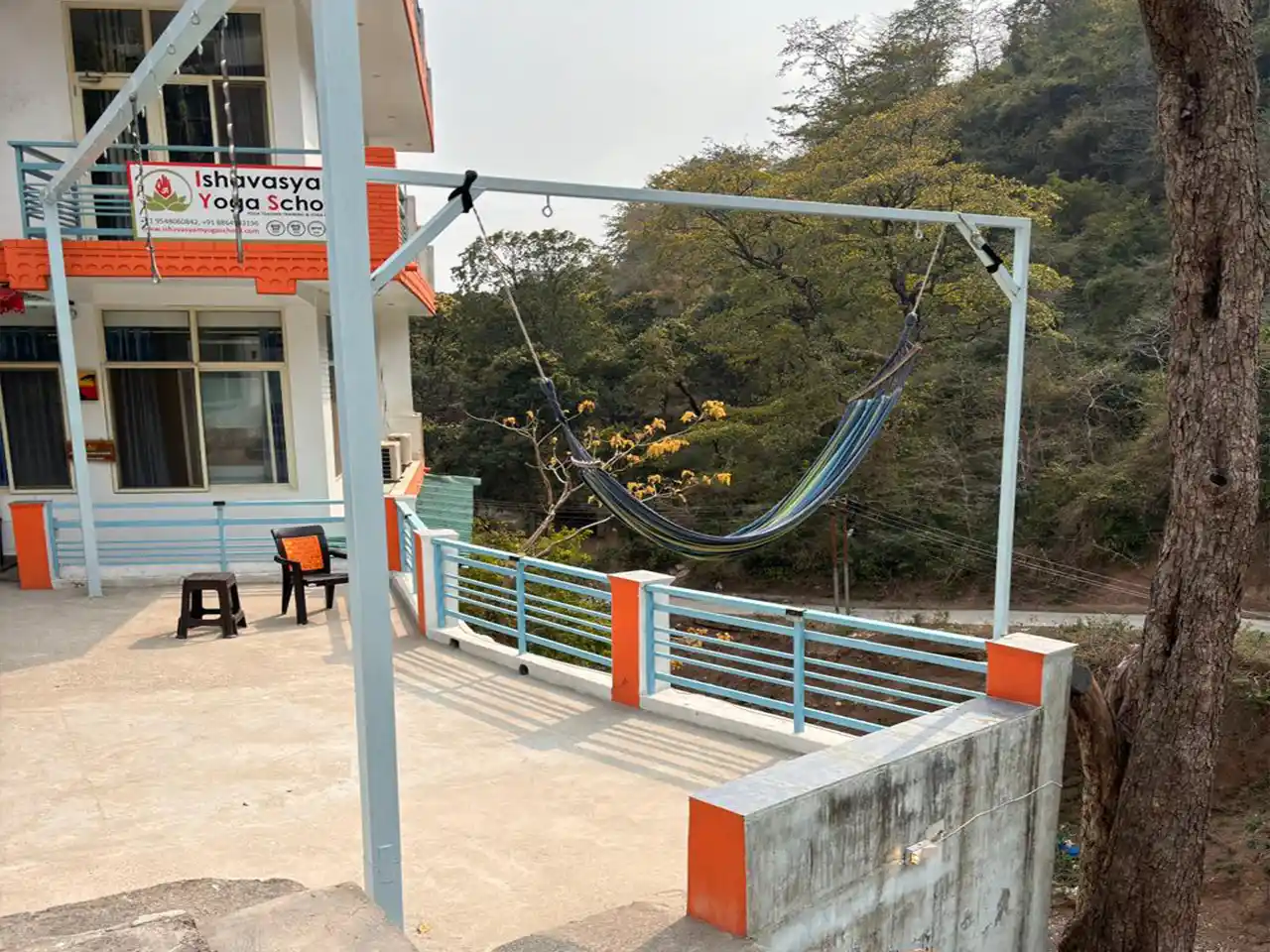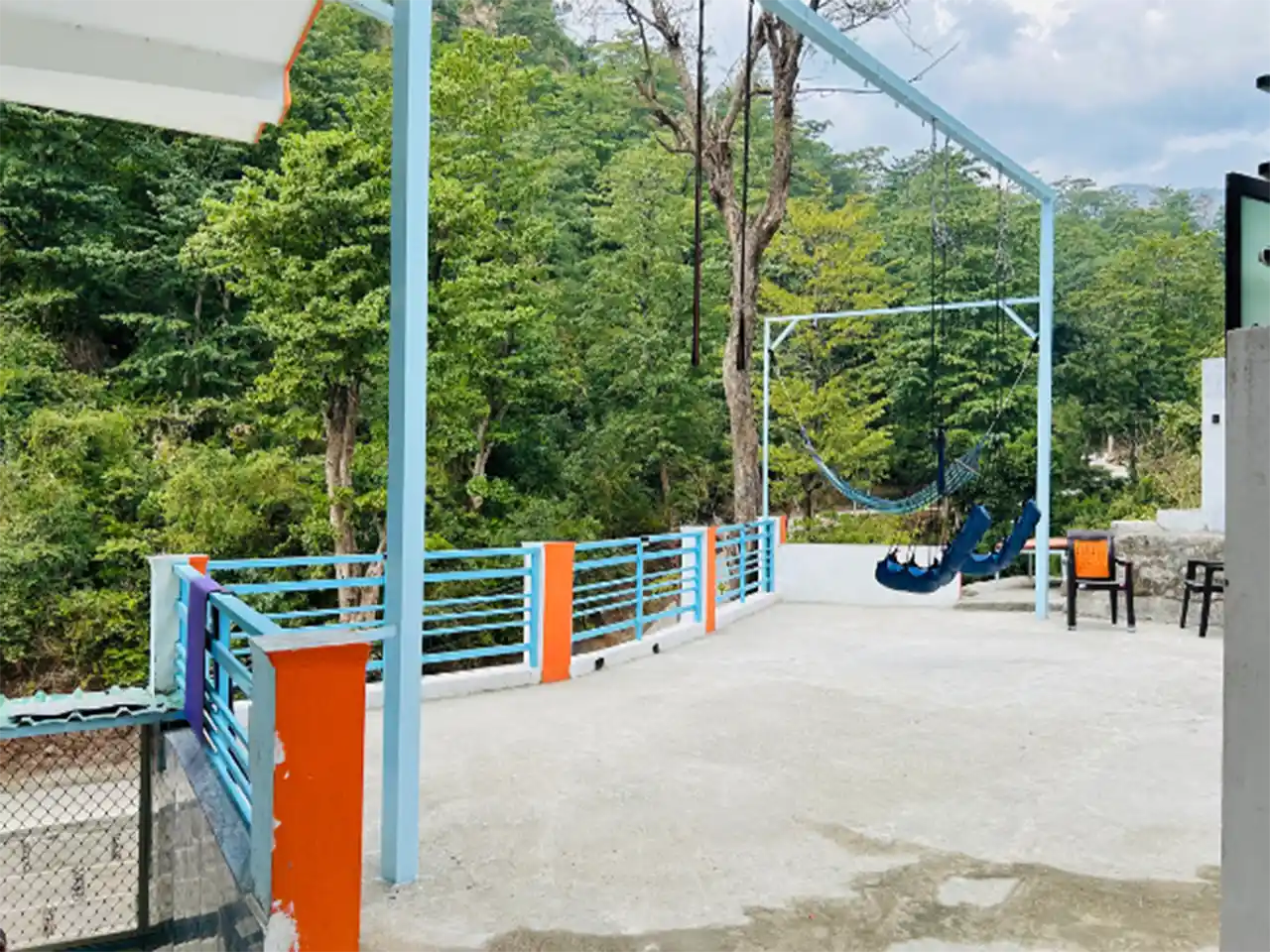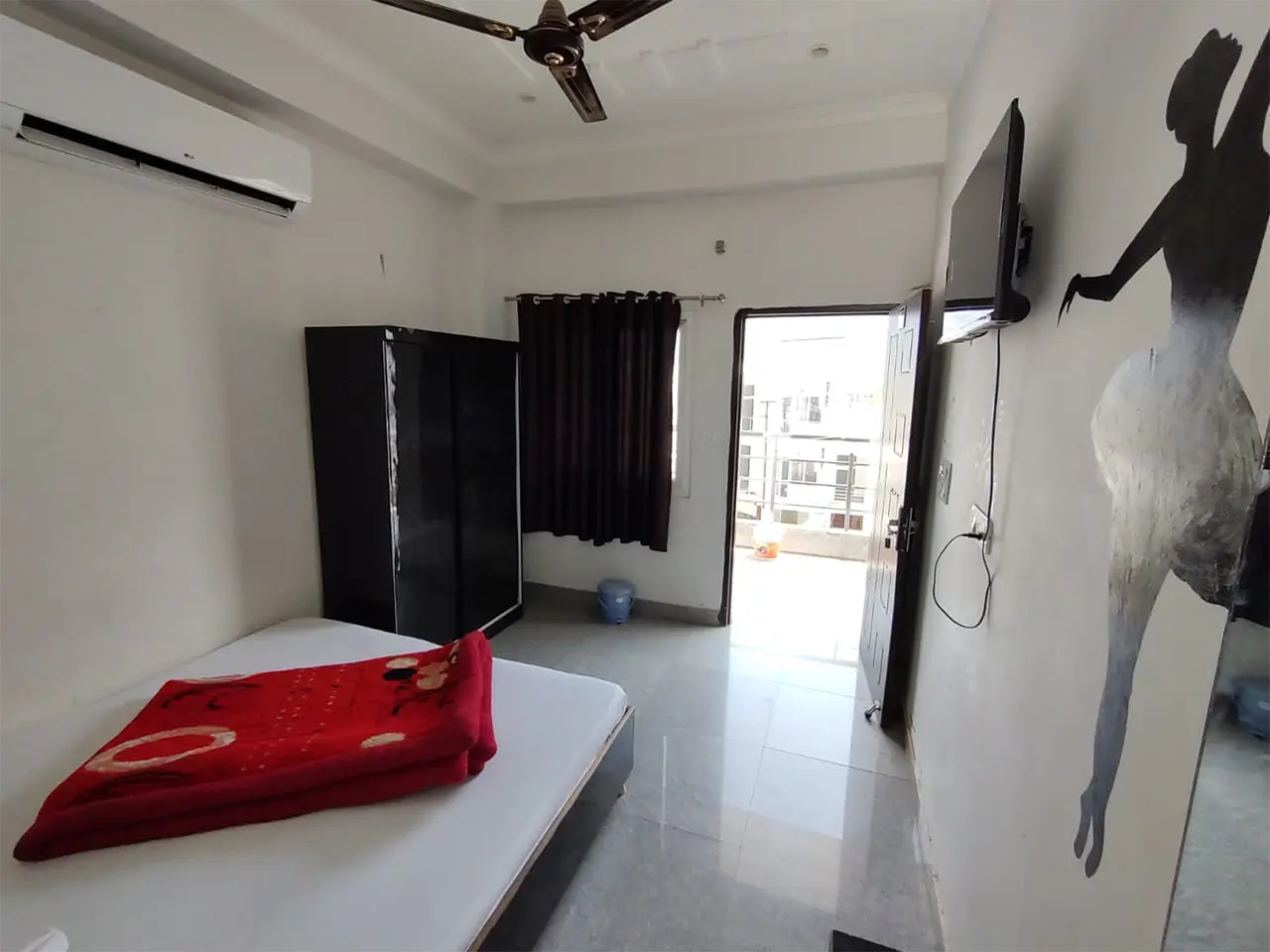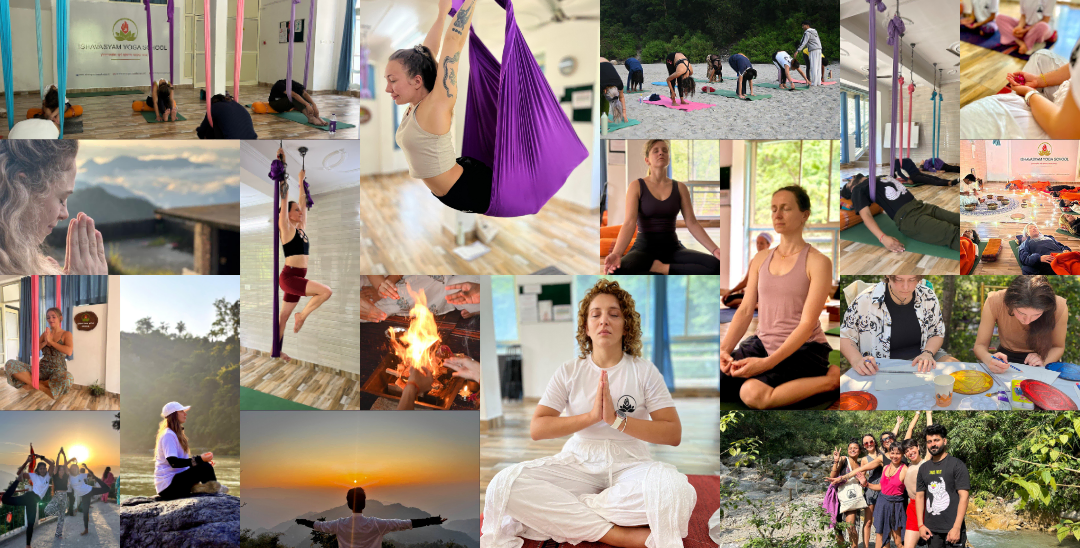
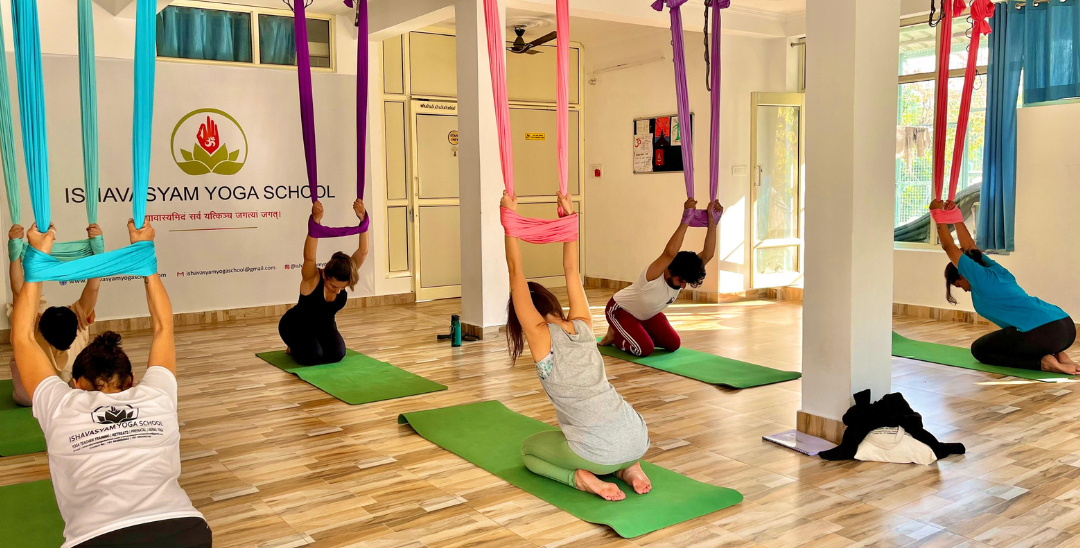

200-Hour Aerial Yoga Teacher Training in Rishikesh (Hatha , Ashtanga, Ayurveda, Yin & Aerial Yoga with Healing Session)
Course Duration: 23 Days.
Begin your transformative journey with our 200 Hours Combo Multistyle + 10 Days Aerial Yoga Teacher Training Course. Designed for aspiring yoga teachers and dedicated practitioners, this program blends the dynamic practice of aerial yoga with various traditional yoga styles, providing a comprehensive and enriching experience. The course starts on the 2nd of every month and concludes on the 23rd, ensuring a structured and immersive learning period.
Embark on a transformative journey that combines the exhilarating grace of aerial yoga with the grounded wisdom of multi-style yoga. In this intensive 200-hour teacher training course in Rishikesh, the "Yoga Capital of the World," you'll:
Ready to take your yoga practice and teaching skills to new heights? Contact us today to secure your spot in our 200-Hour Aerial & Multi-Style Yoga Teacher Training in Rishikesh and embark on a life-changing journey!
Please Read Carefully.
- * Check-In on 2nd between 11AM - 4PM.
- * Orientation & Opening Ceremony on 2nd.
- * Combo Course classes and hours are included within the 23-day complete course time.
- * All classes will start on the 3rd at their given time.
- * All Classes will end on the 23rd.
- * Aerial classes will be from the 3rd to the 14th.
- * Exam (Written & Practical) on 23rd + Graduation.
- * Farewell & Checkout on 24th by 11:00 AM.
- *Twin-sharing accommodation is subject to availability. If full, a private room or dormitory will be the only option.
- * Please read all the School Policies carefully.
- * 100% attendance in all courses is mandatory; uninformed and irrelevant absences will be considered for cancellation of certification.
- ** Pickup or Drop service is only included with Twin Sharing & Private Accommodation participants.
What Is Aerial Yoga?
Aerial Yoga is a joyful, liberating, and deeply healing practice that invites you to stretch beyond the limits of the mat and quite literally rise above. Rooted in the ancient wisdom of traditional Hatha Yoga and modern aerial movement, this practice involves performing yoga postures using a silk yoga hammock suspended from above. Though often called “anti-gravity yoga,” its essence remains grounded in yogic principles—support, surrender, balance, and transformation.
Aerial Yoga first gained momentum in the early 2000s as a unique blend of Iyengar Yoga, aerial dance, Pilates, and gymnastics. The practice was pioneered by Christopher Harrison, a renowned Broadway choreographer and former gymnast, who introduced AntiGravity® Fitness—a method combining yoga philosophy, spiritual awareness, and dynamic movement. Today, aerial yoga is a globally loved wellness practice, celebrated for its joyful, healing experience that builds core strength, enhances flexibility, and elevates both the body and mind.
What makes aerial yoga special is how playful and freeing it is. Whether you're flying into an inversion or gently swaying in Savasana, there's an indescribable magic that comes with moving through the air. Students describe it as fun, meditative, even life-changing. And the anti-gravity yoga benefits are both visible and felt: spinal decompression, improved circulation, enhanced flexibility, reduced joint pressure, and increased upper-body and core strength. More than that, it teaches trust—both in the hammock and in yourself.
Most of all, Aerial Yoga at Ishavasyam Yoga School is fun. It’s empowering. It's transformative. It’s where people from across the globe laugh, fly, sweat, and grow together—held by the sky, and even more so, held by one another. That’s what makes us the best yoga school in Rishikesh for aerial yoga — not just the technique, but the warmth, community, and deep yogic values behind it.
If you're looking to immerse yourself fully, explore our Aerial Yoga Teacher Training in Rishikesh, designed for all levels.
Come and discover what it means to fly with heart — only at Ishavasyam Yoga School.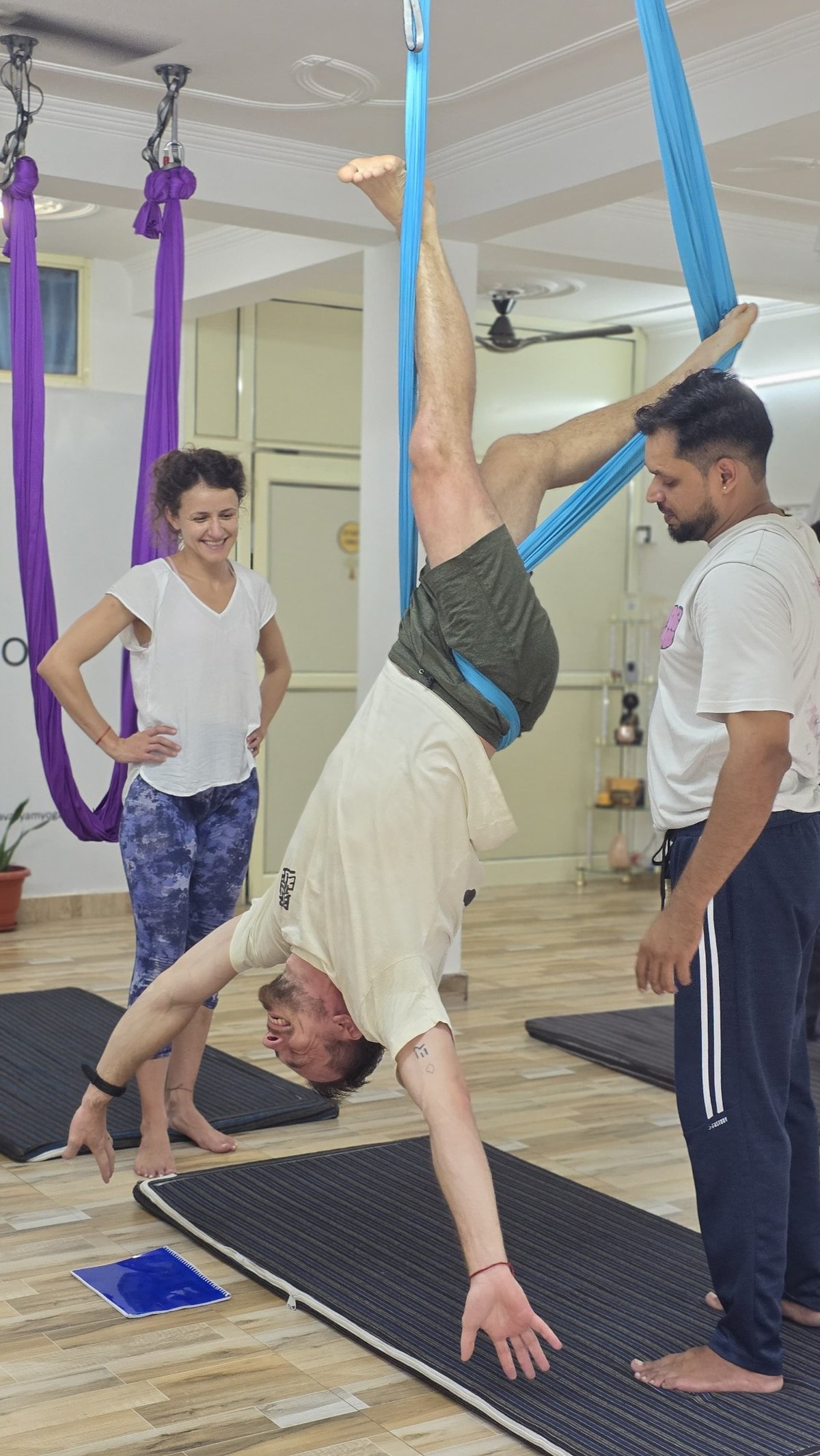
Our Reviews

COURSE CURRICULUM | 200 HOUR AERIAL YOGA TEACHER TRAINING :
Aerial Yoga
Aerial Yoga in the syllabus introduces students to using the hammock as a prop to deepen flexibility, build strength, and experience yoga postures with support and creativity, enhancing both physical alignment and inner awareness.
- Sukhasana (Easy pose)
- Vajrasana (Thunder pose)
- Ardha Uttanasana (Half Forward Bend)
- Utthita Ardha Uttanasana (Flat back)
- Ekapada ardha parsvottanasana (One leg lifted/crunch pose)
- Veer Bhadrasana (Warrior pose 3)
- Balasana (Child pose)
- Balasana (Child pose / lifted hip)
- Marjariasana (Cat and cow pose)
- Bhujangasana (Cobra pose)
- Supta vajrasana (Reclined thunderbolt pose)
- Kati chakrasana (Spinal twist)
- Utkatasana (Chair pose)
- Hasthouttan Asana (Raised arm back arch)
- Viman asana (Aeroplane)
- Veerbhadra asana-3 (Warrior pose 3)
- Padmasana (Lotus pose)
- Trikona asana (Front split)
- Ustrasana (Camel pose)
- Dhanurasana (Bow pose)
- Chakrasana (Wheel pose)
- Uttanasana (Forward bending)
- Trikona asana (Triangle pose)
- Adho Mukha svan asana (Downward facing dog)
- Salabh asana (Locust pose)
- Vrischikasana (Scorpion pose)
- Veerbhadra asana (Warrior pose 1)
- Veerbhadra asana (Warrior pose 2)
- Utthita Parsvakonasana (Side angle pose)
- Viparita veerbhadra (Warrior pose variation)
- Utthita hasta padangusthan asana (Big toe pose)
- Parivartit padangusthan asana (Revolved hand to big toe pose)
- Parshvottan Asana (Pyramid pose)
- Ardha chandrasana (Half moon pose)
- Hanuman asana (Full split pose)
- Kapotasana (Pigeon pose)
- Natraj asana (Dancer pose)
- Tadasana (Mountain pose)
- Tree pose (Vriksha asana)
- Padangusthan asana (Big toe pose)
- Nauka Asana (Boat pose)
- Bandhkonasana (Butterfly pose)
- Drop - Bandhkonasana (Inverted butterfly pose)
- Chaturbhuj asana (Square pose)
- Vipareet asavsanchal Asana (Reversed lunge)
- Shavasana (Corpse pose)
- Dhanu baan asana (Bow and arrow pose)
- Sarvangasana (Shoulder stand)
- Inversion (Upside down)
- Reversed trikonasana
- Shirsh asana (Head stand)
- Urdhva mukha svanasana (Upward facing dog)
- Dhanurasana (Bow pose)
- Malasana (Garland pose)
- Hanuman asana (Split pose)
- Flip locust
- Superhero
- Ekpada prapadh Asana (Single foot sitting)
- Ekpada prapadh Asana (Single foot sitting)
- Sarvangh asana (Shoulder stand)
- Bhujangasana (Cobra pose)
- Vampire pose
- Ardhachandra asana (Half moon pose)
- Viparit badhkon asana (Reversed butterfly pose)
- Ballerina pose
- Seahorse pose
- Butterfly pose
- Halasana (Plough asana)
- Skandasana (Wide-legged squat)
- Yogi pose
- Viparit padmaasana (Inverted lotus)
- Kapot asana (Pigeon pose)
- Padmaasana (Lotus pose)
Hatha & Yin Asana
Hatha Asana The practice of Haṭha āsanas is not merely physical exercise but a tool to harmonise the body (śarīra), breath (prāṇa), and mind (manas). It purifies the body, strengthens the nervous system, opens the energy channels (nāḍīs), and prepares the practitioner for deeper practices like prāṇāyāma and meditation.
-
Syllabus:
- Surya Namaskar
- Pawanmuktasana series 1
- Pawanmuktasana series 2
- Chandra Namaskar (Moon salutation)
- Tadasana (palm tree pose)
- Triyak tadasana (swaying palm tree pose)
- Trikonasana (triangle pose)
- Parivirtatrikon asana – revolving triangle pose
- Virabhadrasana 1 -warrior 1
- Virabhadrasana 2 -warrior 2
- Virabhadrasana 3 -warrior 3
- Ardha Chandrasana- Half moon pose
- Vrikshasana – tree pose
- Parvatasana – mountain pose
- Adho mukha svanasana – downward facing dog
- Kati chakrasana – waist rotating pose
- Trikonasana (triangle pose)
- Parivirtatrikon asana – revolving triangle pose
- Garudasana – eagle pose
- Baddha Konasana- bound angle pose
- Rajkapoot asana – pigeon pose
- Urdhva mukha svanasana –upward facing dog
- Matsyasana
- Setu Bandhasana
- Ustrasana
- Dhanurasana
- Salabhasana
- Supta Virasana- reclining hero pose
- Virasana –hero pose
- Vajrasana –thunderbolt
- Gomukhasana
- Balasana
- Dandasana
- Ardha Matsyendrasana
- Hanumanasana (Full split)
- Santulan Asana (Balancing pose)
- Veerbhadra asana 3 (Warrior pose -3)
- Phalakasana (Plank pose)
- Anjaneya asana (Low/Deep lunge)
Ashtanga Vinyasa
Ashtanga Vinyasa is a dynamic system of yoga that combines asana (posture) , pranayama (breath control) , and vinyasa (breath-synchronized movement) in a structured and flowing sequence. Rooted in the ancient teachings of Patanjali’s Ashtanga (eight-limbed) Yoga , this style was codified and popularized in the modern era by Sri T. Krishnamacharya and his student Sri K. Pattabhi Jois in Mysore, India.
-
Syllabus:
- Surya Namaskar (Alignment, Drishti, Adjustment, Options)
- Surya Namaskar A
- Chandra Namaskar (Moon Salutation)
- Surya Namaskar B
- Padangusthasana
- Padahasthasana
- Utthita Trikonasana
- Parivrtta Trikonasana
- Utthita Parsvakonasana
- Parivrtta Parsvakonasana
- Prasarita Padottanasana A, B, C, D
- Parsvottanasana
- Eka Pada Padangusthasana A, B, C, D
- Ardha Baddha Padmottanasana
- Utkatasana
- Virabhadrasana A & B
- Dandasana
- Paschimottanasana A, B, C, D
- Purvattanasana
- Ardha Baddha Padma Uttanasana
- Triang Mukhaikapada Paschimottanasana
- Janu Sirsasana A, B, C
- Marichyasana A, B, C, D
- Navasana
- Bhujapidasana
- Kurmasana
- Supta Kurmasana
- Garbha Pindasana
- Kukkutasana
- Baddha Konasana A & B
- Konasana
- Upavishta Konasana
- Supta Konasana
- Supta Padangusthasana A & B
- Ubhaya Padangusthasana
- Urdhva Mukha Paschimottanasana
- Setu Bandhasana
- Urdhva Dhanurasana
- Salamba Sarvangasana
- Halasana
- Karnapidasana
- Urdhva Pindasana
- Urdhva Padmasana
- Sirsasana
- Urdhva Dandasana
- Baddha Padmasana
- Yogimudra
- Uplutih
- Savasana
Pranayama & Meditation
Pranayama Derived from the words prana (vital life force) and ayama (extension or control), Pranayama refers to the conscious regulation and expansion of the vital energy through disciplined breath control. Meditation is the state of meditative absorption, where the mind becomes still, the senses withdraw inward, and the practitioner experiences deeper states of awareness, inner peace, and union with the Self (Ātman or Puruṣa).-
Syllabus:
Pranayama
- Definition of Pranayama
- Four Aspects of Pranayama.
- Asana for the Pranayama
- Sectional Breathings
- Need of Breath.
- Natural Breathing.
- Chandra Bhedi Pranayama (Moon piercing breath)
- Surya Bhedi Pranayama (Sun piercing breath)
- Nadi Shodhana Pranayama (Alternate nostril breath).
- Ujjayi Pranayama (Ocean breath).
- Sheetali & Sheetkari Pranayama (Cooling breath).
- Bhastrika.
- Shatkarmas.(Cleansings)
- Tri Doshas.
- Purpose of life & its dimensions.
- Introduction of Meditation.
- Origin & history of Meditation.
- Breath awareness Meditation.
- AUM chanting Meditation.
- Trataka Meditation.
- Dynamic Meditation.
- Moola Bandha - Anal Lock.
- Uddiyana Bandha - Abdomen Lock.
- Jalandhara Bandha - Chin Lock.
- Maha Bandha - Practice of all three Bandhas at the same time.
Yoga Philosophy & Life Management
Yoga Philosophy offers a deep understanding of the ancient yogic texts, principles, and ethics, helping students connect the practice on the mat with a meaningful, conscious lifestyle off the mat.-
Syllabus:
The Great Yogis
- Anandamayi Ma.
- Mata Bhagwati Devi.
- Swami Vivekanada.
- Paramahansa Yogananda.
- Three Gunas.
- Cause & types of pain.
- The monkey mind.
- Sanatana Dharma.
- Vedas
- The Four Goals of Life.
- Four Stages of Life.
- The Vedic System of Duties.
- Law of Karma.
- Puranas.
- The Six Systems of Indian Philosophy.
- Jnana Yoga
- Bhakti Yoga
- Karma Yoga
- Mantra Yoga.
- Hatha Yoga.
- Raja Yoga.
- Purpose of life & its dimensions.
- Importance of Self-Evaluation.
- Duties & Commitment of Self, Family and Society.
- Adjustment with Self &Environment.
- Positive way of thinking.
- Tools & techniques for Positive thinking.
- Karma & Karma Phal Sidhanta.
- Behavioural Skill.
Applied Yoga Anatomy & Bio Mechanics
Applied Yoga Anatomy & Biomechanics is the conscious integration of ancient yogic wisdom with modern anatomical science and movement mechanics. It empowers practitioners and teachers to understand the body’s structure, movement patterns, and energy flow in relation to yogic practices.-
Syllabus:
- Functional anatomy of the skeletal, muscular, and nervous systems in yoga
- Biomechanical principles behind alignment, balance, and movement
- Joint range of motion and stability during static and dynamic postures
- Postural assessment and intelligent modifications for all body types.
- Yoga therapy insights to address physical imbalances and discomfort
Ayurveda & Life-Style
Derived from the Sanskrit words āyus (life) and veda (knowledge or science), Āyurveda means “the science of life.” It is an ancient holistic system of health and healing that emphasizes harmony between body, mind, spirit, and environment. Ayurveda offers personalized guidance on diet (āhāra), daily routines (dinacharyā), seasonal practices (ṛtucharyā), and natural therapies to maintain or restore balance.-
Syllabus:
- History of Ayurveda.
- Branches of Ayurveda.
- Pillars of Ayurveda.
- Ayurveda & Health.
- Tri-Doshas & Body Types.
- Tastes & Diet.
200 Hours Aerial Yoga Teacher Training Course
Daily Schedule

| Time | Class |
|---|---|
| 05:15 AM - 06:15 AM | Pranyama & Meditation Practice (shatkarma) |
| 06:15 AM - 07:45 AM | Asana Class (Hatha Yoga / Yin Yoga) |
| 07:45 AM - 08:30 AM | Breakfast |
| 08:30 AM - 09:30 AM | Applied Yoga Anatomy & Bio Mechanics |
| 10:00 AM - 11:30 AM | Aerial Asana |
| 11:30 AM - 1:30 PM | Lunch |
| 01:45 PM - 02:45 PM | Ayurveda (from 14th) |
| 02:45 PM -04:00 PM | Aerial Sequence |
| 02:45 PM - 03:45 PM | GD - Teaching Methodology (From 14th) |
| 03:45 PM - 4:15 PM | Tea Break |
| 04:15 PM - 05:30 PM | Yog Philosophy |
| 05:45 PM - 07:15 PM | Ashtanga Vinyasa / Adjustment & Alignment (Wed. & Sat.) |
| 07:15 PM - 8:00 PM | Dinner |
| 10:00 PM | Lights Off |
*This is a tentative schedule for yoga teacher training course, and can be changed.
Course Fee : 200 HOUR AERIAL YOGA TEACHER TRAINING
| Payment Details
|
|||
| Accom. Type | Total Fees | PayPal Booking ($200) | |
|---|---|---|---|
| Only Course | $699 | ||
| 4 Sharing Dormitory |
|
||
| 2 Sharing (Same Gender) |
|
||
| Private Accomm. |
|
||
Your Checklist
Included!
| 23 Days & 22 Nights Accommodation |
|---|
| 10 days of Aerial Yoga & Aerial Flow |
| Yoga material |
| Excursion |
| Daily, 3 times, yogic food and tea |
| Pick-up or drop-off (DED Airprot) (except for those who book the dorm room) |
Not Included
| Air-conditioner / Room Heater (On Additional Charges) |
|---|
| Visa fee/Air fare/Taxi pick-up from Delhi, Haridwar |
Packing
| Carry a valid Identification Card. |
|---|
| Carry your toiletries. Also You can Buy From Here with the nearby Shops. |
| Carry personal towels and hygiene items, metal water bottle. |
| Carry a hand towel, an universal adapter for charging the devices. |
Packing
| Carry your own yoga mat if possible. The school also provides yoga mats for sharing. |
|---|
| Carry a raincoat or umbrella. |
| Bring comfortable clothes for yoga classes. Avoid Leggings and other tights or synthetic materials. |
| Bring one pair of white clothes for the ceremony. |
| Sandals or flip-flops. |
| Also bring some clothes which cover the body, in case you want to visit the temples. |
| Carry a hand towel, an universal adapter for charging the devices. |

Namaste and we look forward to guiding you on your yoga journey at
Ishavasyam Yoga School.
Contact Us!
Register Now
FAQs - 200 Hours Aerial Yoga Combo Course
Yes, aerial yoga is designed for all fitness levels, including beginners! The hammock provides support, allowing you to ease into poses at your own pace. Instructors guide you through basic movements and help you build strength and flexibility gradually.
Wear comfortable, form-fitting clothes that cover your legs and arms to avoid friction with the hammock. Avoid loose clothing that might get tangled. It’s also best to remove any jewellery, as it can snag the fabric.
Aerial yoga can help with spinal decompression and improve flexibility, which may alleviate some forms of back pain. However, if you have any medical conditions (like high blood pressure, vertigo, or joint issues), it's important to consult with your healthcare provider before trying aerial yoga.
Ishavasyam Yoga School focuses on the quality of education, to maintain it the maximum strength of a batch is between 10-12 Students / batch.
The closest airport to the school is Jolly Grant Airport - Dehradun.
Not at all! The Aerial Combo Course is perfectly structured to be completed in just 23 days, from the 2nd to the 23rd of each month. This allows you to gain comprehensive knowledge within a set timeframe without needing to extend your stay.
Yes, there will be an exam in the end, and to pass the exam, students need to score a minimum 50% and have to complete the assignments on time.
Absolutely! We encourage you to explore additional subjects by attending our demo class and seamlessly integrating them into your current course.
The School provide the study material upon arrival. If you want you can bring your yoga mat, but not necessary.
Sure, you can shift the date of joining (only twice) in any upcoming course dates within the next 12 months from the date of the booking month.
Yes, if you are unable to join the course within a year, you will need to register again and pay the booking amount.
Yes, you are welcome to stay longer after the course! Please let us know in advance, and we can assist with the necessary arrangements.
Yes, accommodation is typically shared with the same gender, except in the common dorm or if you are opting for a room specifically for couples or friends.
Photo Gallery
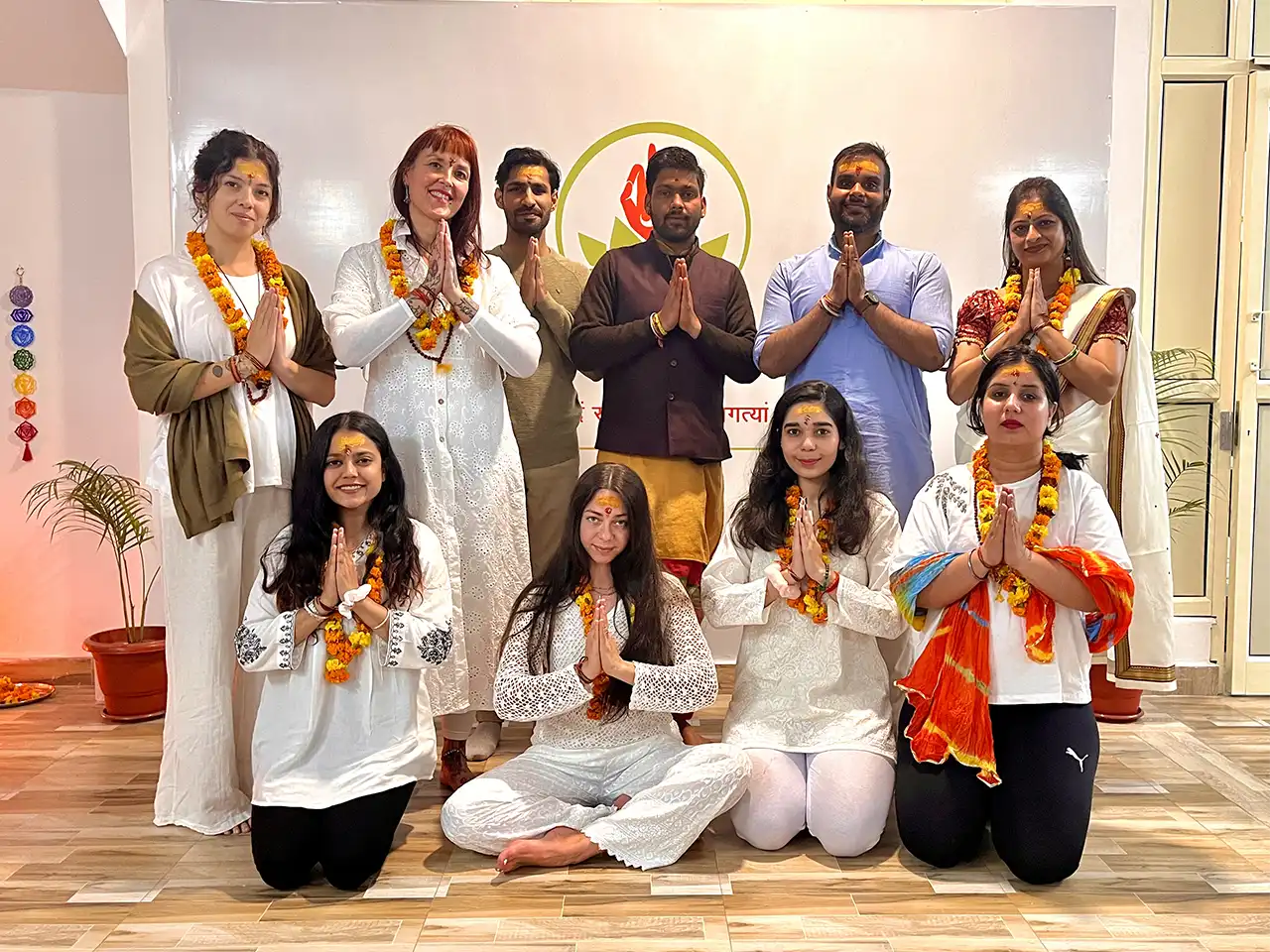
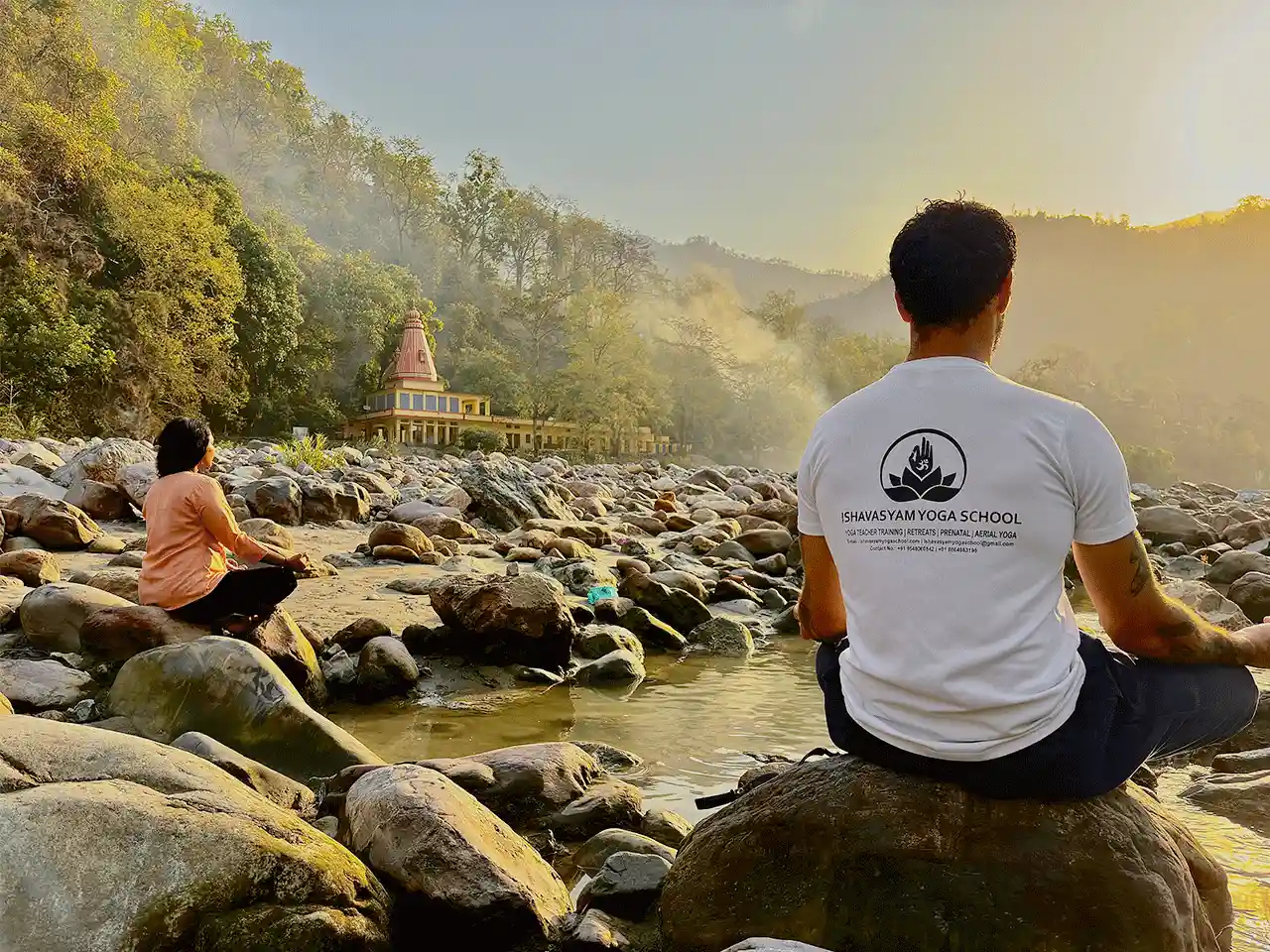
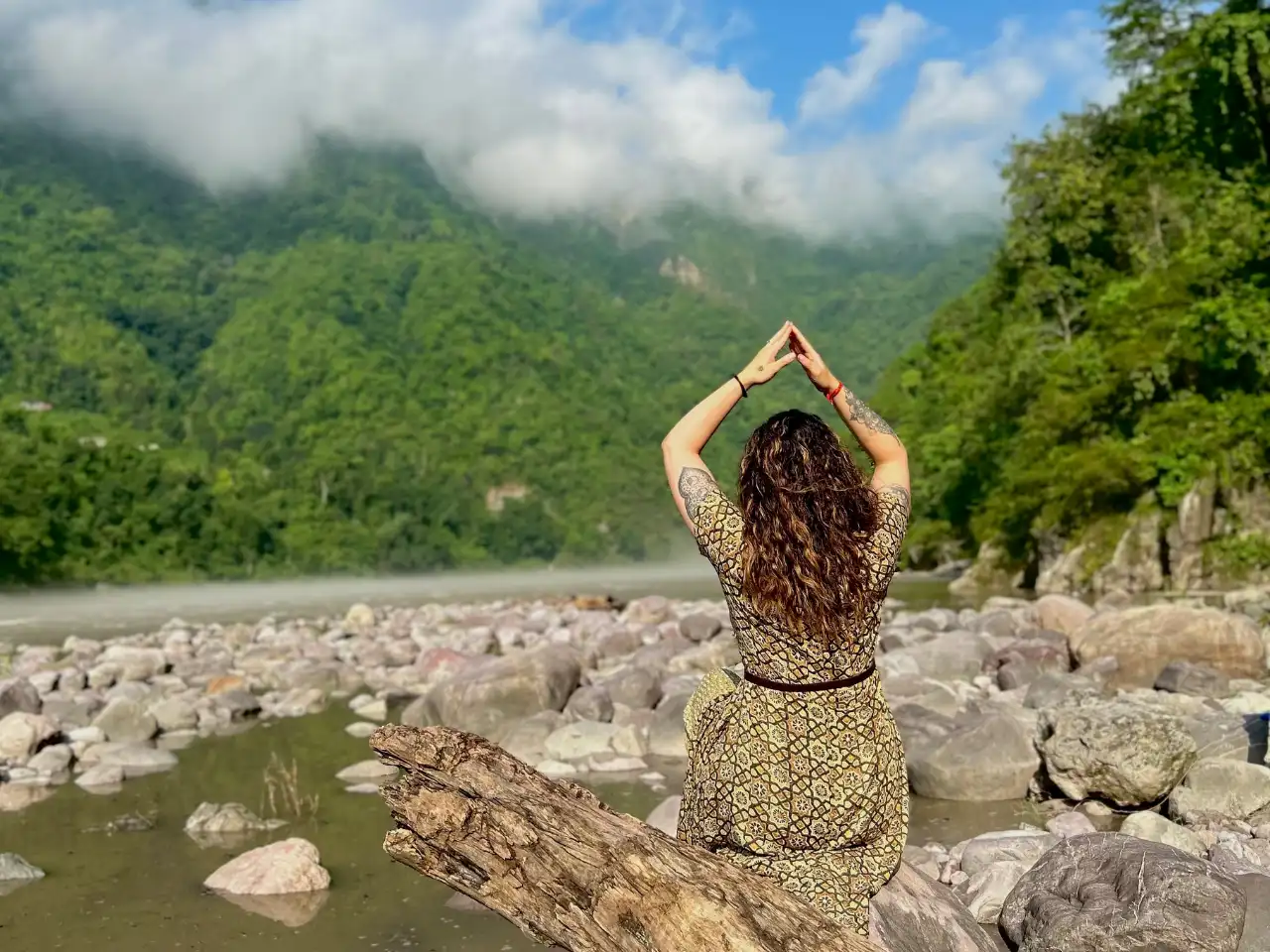

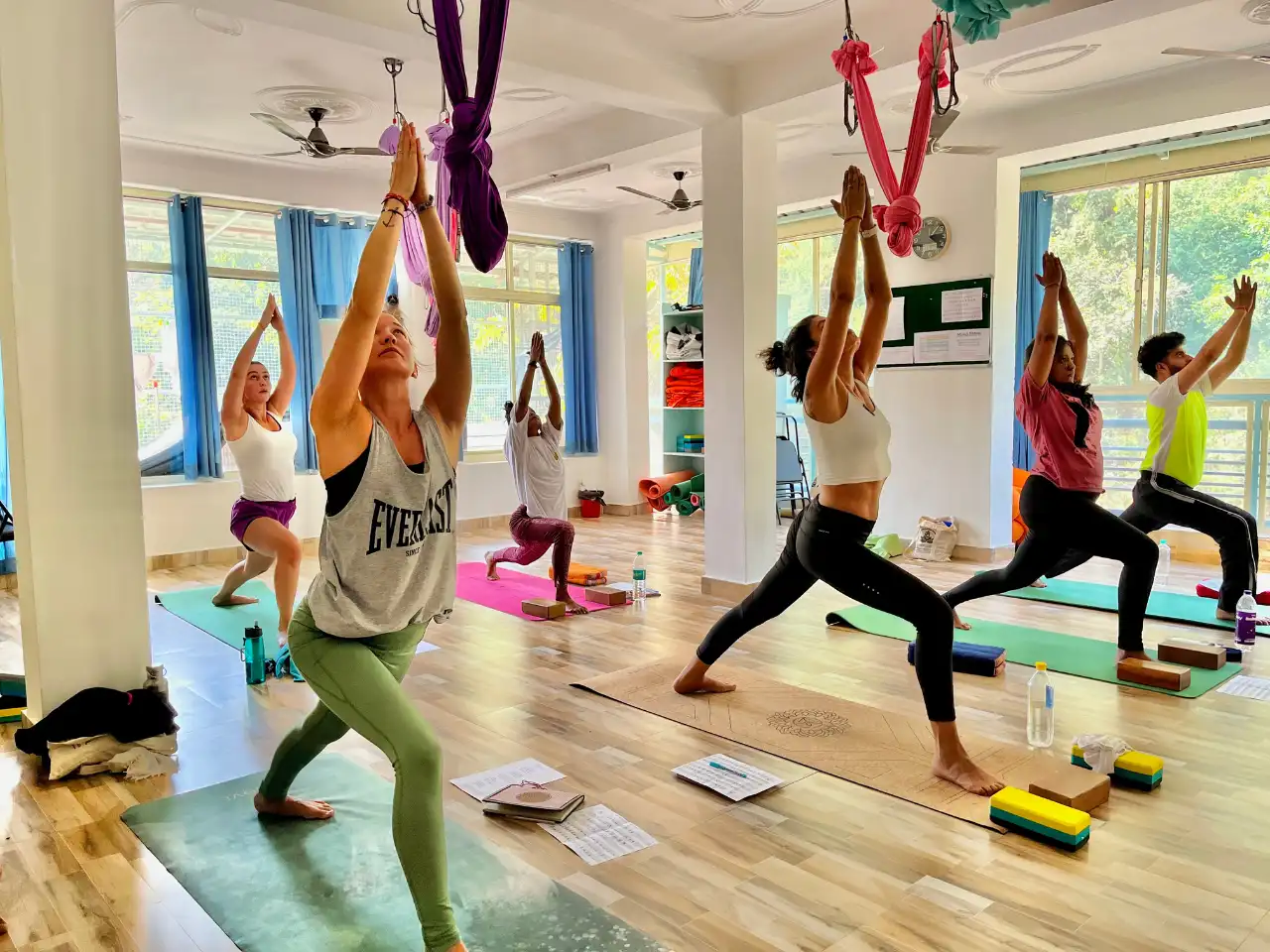
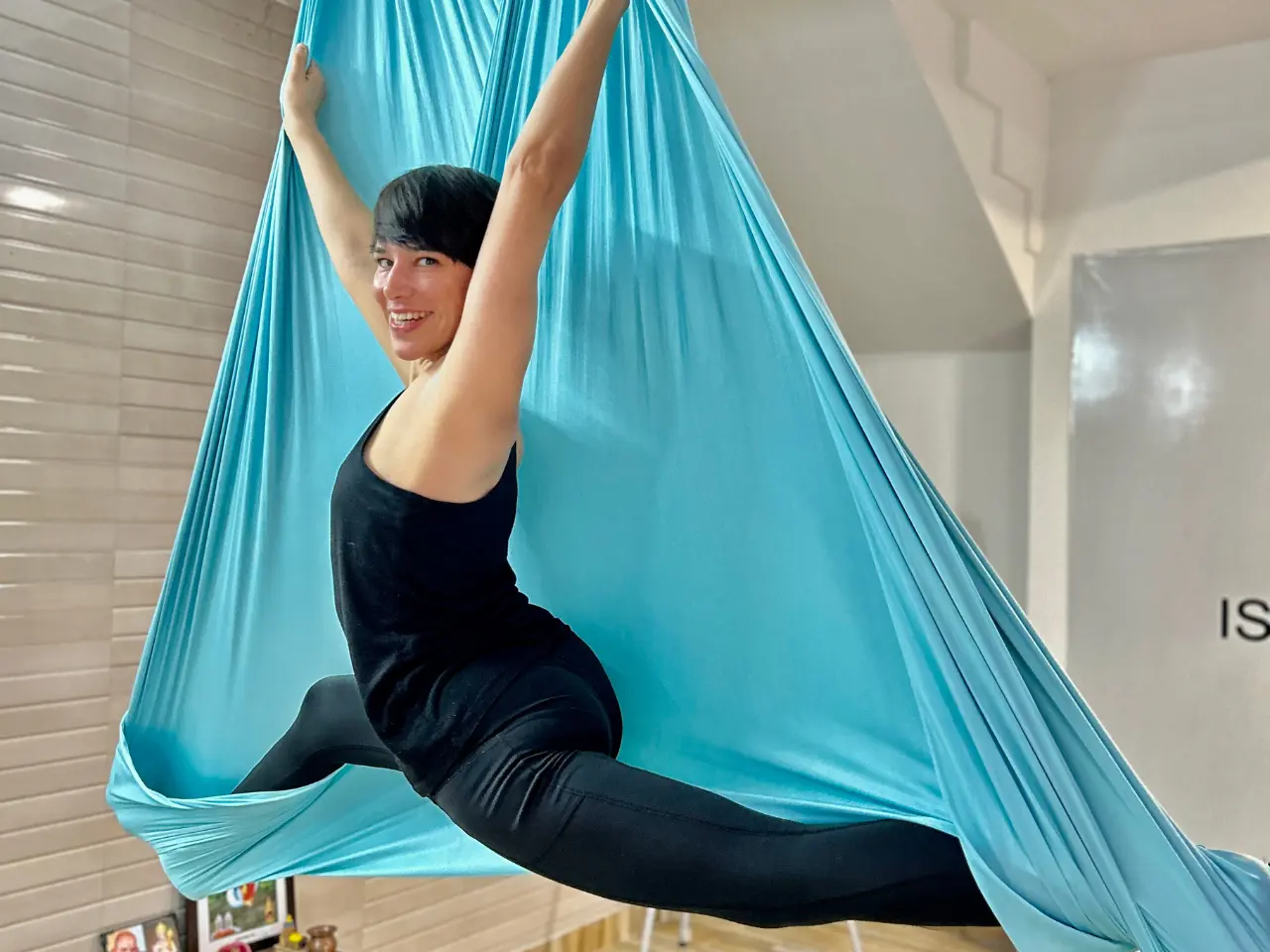
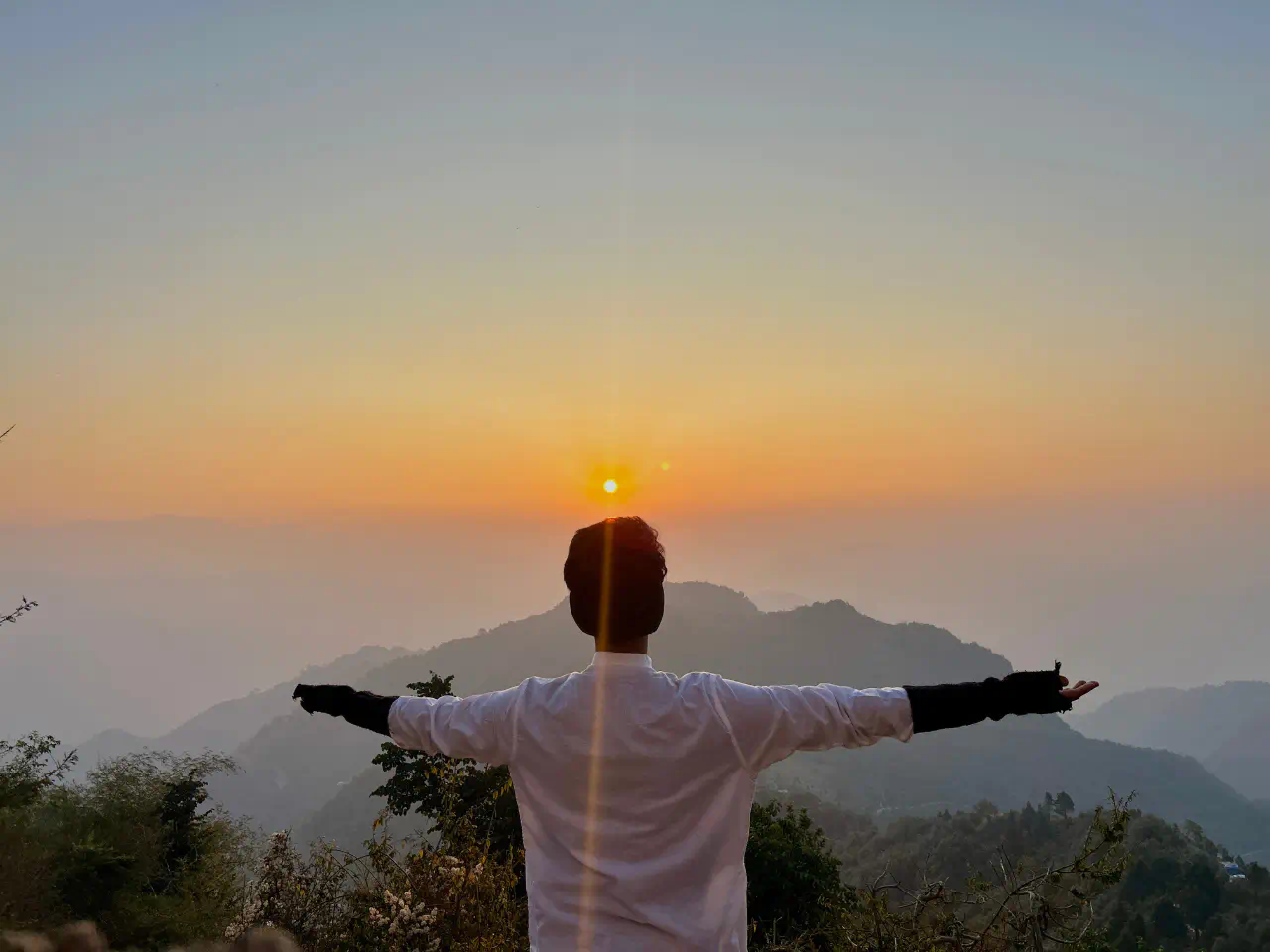
Accommodation Gallery
